January 6 - 13. BANGKOK continued... "Home Cooking at The Thai House" Food is reason enough to visit Thailand. In world where all cuisines are not created equal, Thai food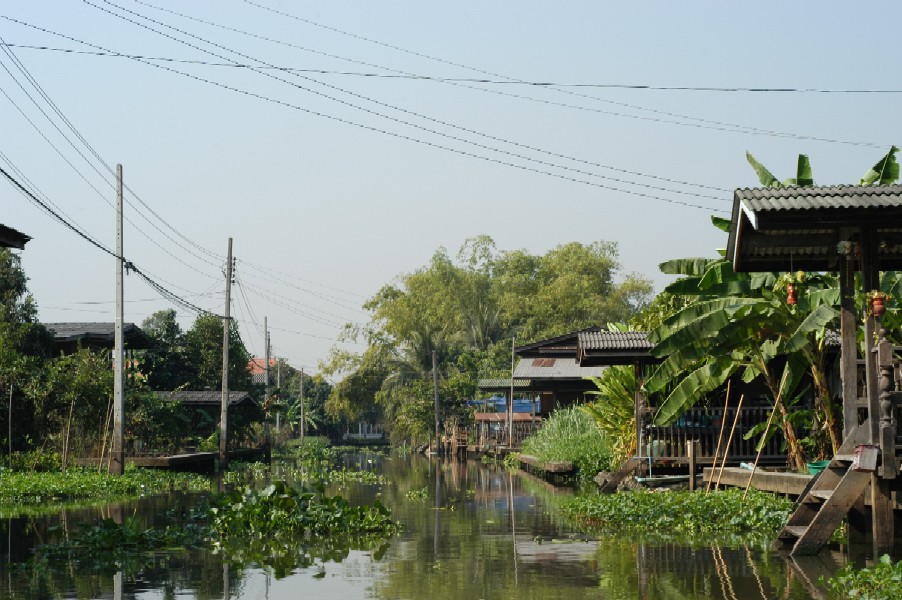 stands out as one of the most exceptional. The unique mixture of fresh vegetables, meat and seafood, fragrant herbs, and the rich and savory flavors of coconut and peanuts, is in a class all their own. Early on I began looking for a Thai cooking class and finally called a couple of places. It was just my luck the The Thai House (www.thaihouse.co.th) had a full-day class later in the week. Rob opted not to join me, claiming it would be full of women, so I went on my own. They picked me up in a van at the hotel. The young woman who greeted me seemed to be well known at the hotel. She said her family knew the manager of the of the hotel and that they had let her mother stay there when she needed to be taken care of while she was pregnant with twins. This young woman was one of the twins. Even in a city the size of Bangkok it felt like a small town. The helpfulness and warm hospitality of the Thais was something I had always remembered from my first visit. They seem to smile often and express an indomitable spirit of happiness, even in difficult times. Even after decades of tourism development they still manage to make you feel genuinely welcomed and I think they really mean it. stands out as one of the most exceptional. The unique mixture of fresh vegetables, meat and seafood, fragrant herbs, and the rich and savory flavors of coconut and peanuts, is in a class all their own. Early on I began looking for a Thai cooking class and finally called a couple of places. It was just my luck the The Thai House (www.thaihouse.co.th) had a full-day class later in the week. Rob opted not to join me, claiming it would be full of women, so I went on my own. They picked me up in a van at the hotel. The young woman who greeted me seemed to be well known at the hotel. She said her family knew the manager of the of the hotel and that they had let her mother stay there when she needed to be taken care of while she was pregnant with twins. This young woman was one of the twins. Even in a city the size of Bangkok it felt like a small town. The helpfulness and warm hospitality of the Thais was something I had always remembered from my first visit. They seem to smile often and express an indomitable spirit of happiness, even in difficult times. Even after decades of tourism development they still manage to make you feel genuinely welcomed and I think they really mean it.
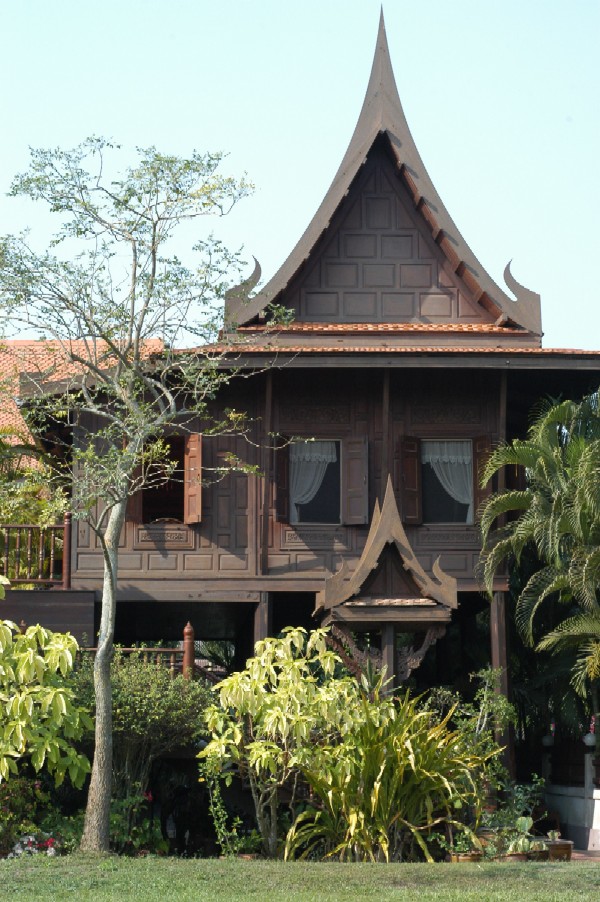 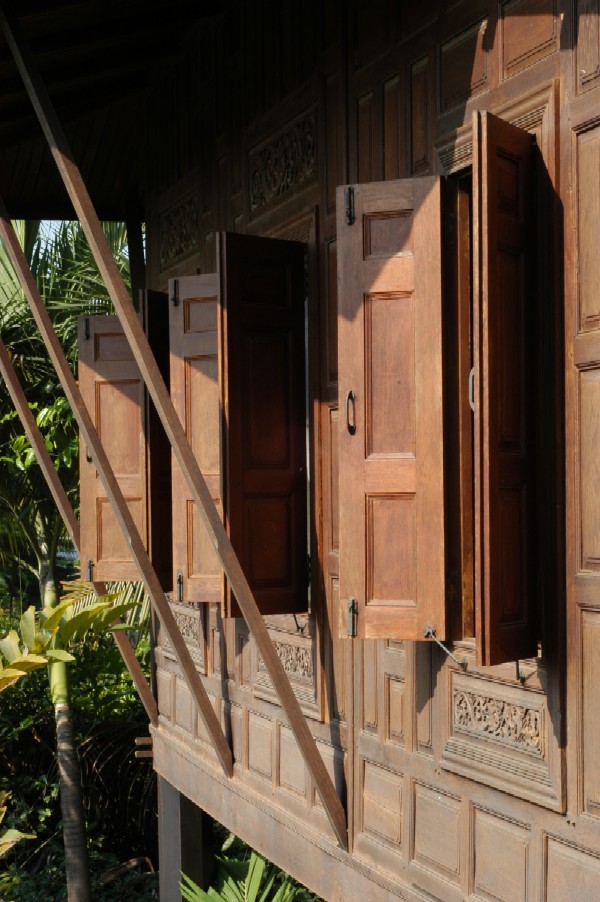 From the hotel they took me to a dock along the main river in Bangkok, the Mae Nam Chao Phraya, where ferries and boat taxis plied the river all day long. I was put on a long-tail boat with the other three "students", who all happened to be men. The long-tail boats were slender river boats, often decorated in bright colors and covered with a canopy. An outboard motor attached to the back with a long rudder enabled them to navigate at high speed around the rivers and channels of Bangkok. Once I settled into my seat at the front of the boat we were off with a powerful roar of the motor. The boat made a giant turn and crossed the river, exiting down a narrower tributary to the east and passing the covered docks of the royal barges. The young woman who picked me up didn't join us on the boat but there was a man on board who pointed out some interesting points during the ride. We passed a large temple that stood right along the water. The From the hotel they took me to a dock along the main river in Bangkok, the Mae Nam Chao Phraya, where ferries and boat taxis plied the river all day long. I was put on a long-tail boat with the other three "students", who all happened to be men. The long-tail boats were slender river boats, often decorated in bright colors and covered with a canopy. An outboard motor attached to the back with a long rudder enabled them to navigate at high speed around the rivers and channels of Bangkok. Once I settled into my seat at the front of the boat we were off with a powerful roar of the motor. The boat made a giant turn and crossed the river, exiting down a narrower tributary to the east and passing the covered docks of the royal barges. The young woman who picked me up didn't join us on the boat but there was a man on board who pointed out some interesting points during the ride. We passed a large temple that stood right along the water. The 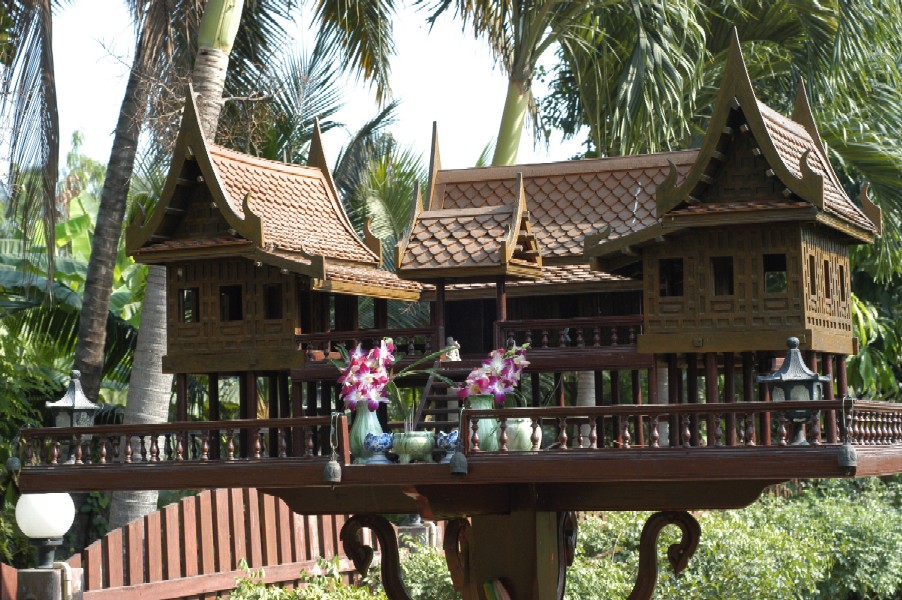 part of the river directly in front of the temple was teeming with fish. Apparently the temple forbade any fishing in that area so the fish had learned it was a save haven for them. part of the river directly in front of the temple was teeming with fish. Apparently the temple forbade any fishing in that area so the fish had learned it was a save haven for them.
After traveling east for a while we turned south onto a smaller tributary. Traditional wooden Thai houses overhung the river on both sides, river docks serving as driveways off of the waterway. It was a very peaceful environment, in contrast to the hustle and bustle of central Bangkok. People were working away at their daily chores or just sitting along the river and watching some time pass by. Dogs lazily lounged on the docks, not even bothering to notice the high pitched purr of our boat motor. Once the boat stopped we could hear the silence of the backwaters, punctuated only by the boat motors plying the waterways. We were transferred to a smaller boat so we could be transported down a side canal to The Thai House. It wasn't a conspicuous house, built from dark wood and hidden by foliage along the canal, but it was a truly lovely place. A short path led us to a covered patio where a table had been set up for our class. While we waited for the final prep work to finish we were shown around the house and offered some coffee or tea. The bottom floor consisted primarily of one large spa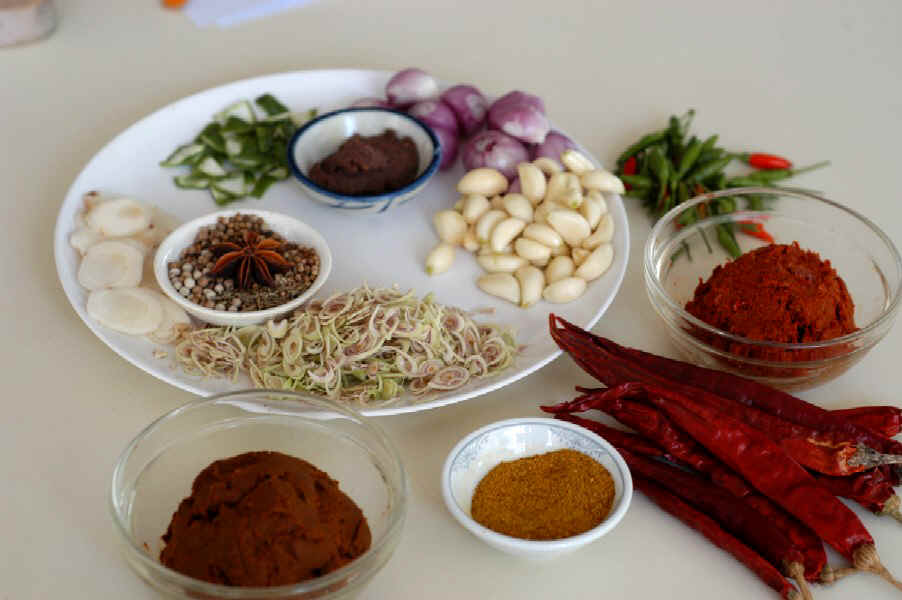 cious room decorated with wooden furniture. Doors opened along two sides, making the room feel like it was part of the outdoors. Stairs led up the outside of the house to a courtyard patio on the second floor that was surrounded by cozy guest rooms. The Thai House also offered lodging for their multi-day classes. Behind the house was a large lawn covered area with a substantial spirit house carefully erected on one side. Thais kept a spirit house perched in their yards so the spirits had a comfortable place to live and wouldn't interfere with the living. They reminded me of an cious room decorated with wooden furniture. Doors opened along two sides, making the room feel like it was part of the outdoors. Stairs led up the outside of the house to a courtyard patio on the second floor that was surrounded by cozy guest rooms. The Thai House also offered lodging for their multi-day classes. Behind the house was a large lawn covered area with a substantial spirit house carefully erected on one side. Thais kept a spirit house perched in their yards so the spirits had a comfortable place to live and wouldn't interfere with the living. They reminded me of an 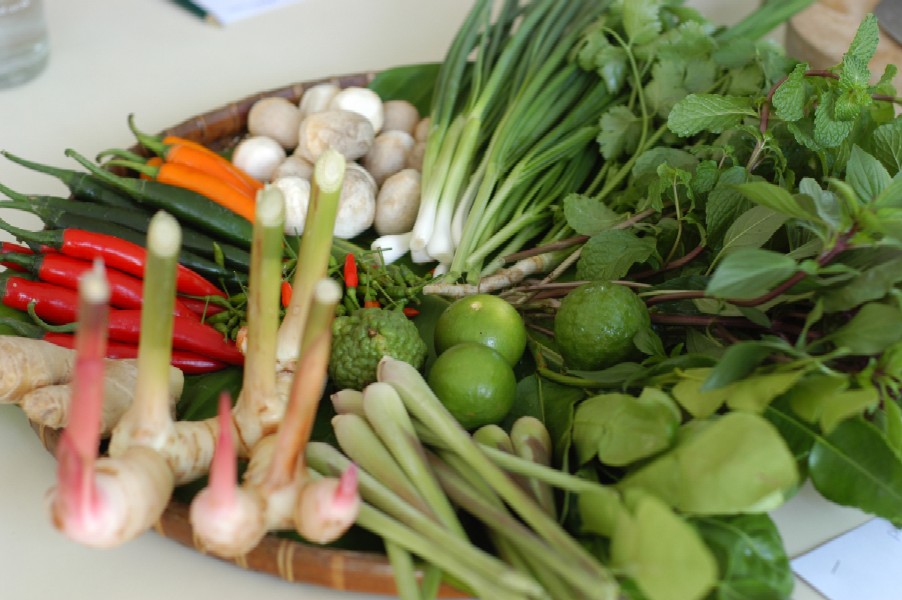 elaborate doll house but they were built on a post like we build a bird house. The front of the spirit house served as an altar where offerings were made to show respect for the spirits and keep them happy, similar to the ancestor shrines kept in Japanese homes. Spirit houses were even found in front of large buildings in downtown Bangkok. elaborate doll house but they were built on a post like we build a bird house. The front of the spirit house served as an altar where offerings were made to show respect for the spirits and keep them happy, similar to the ancestor shrines kept in Japanese homes. Spirit houses were even found in front of large buildings in downtown Bangkok.
Our cooking teacher, Pip, was an energetic and cheerful woman who clearly had experience teaching foreigners how to cook Thai food. The class had an informal and homey feel to it but was still very organized and professional. She introduced herself and wrote her name on our recipe sheets. It was helpful since the Thai language is hard for me to grasp. She also wrote each of our names in the Thai script. As I mentioned, my fellow students were all men. One was a Swedish man, who was also staying as a guest of The Thai House. The other two were a British journalist, who lived in Bangkok, and his German father-in-law. The journalist had covered The Thai House for an article and wanted to come back and try the classes out for himself. The four of us sat around a small square table, each with our own knife and round tamarind cutting board, made from a cross-section of the tamarind tree trunk.
Our menu for the day consisted of five dishes: Tom Yam Kung (Sour and Spicy Prawn Soup), Lap Mu (Savory Chopped Pork Salad), Phat Thai Sai Khai (Fried Noodle Thai Style), Kaeng Ka-ri Kai (Curried Chicken), and Pha-Naeng Neua (Beef Curried in Sweet Peanut Sauce). Pip walked us through the names and translated the words for us. She explained how each dish was created with a balance of sour, spice and salt. For example, in Lap Mu, the sour flavor came from 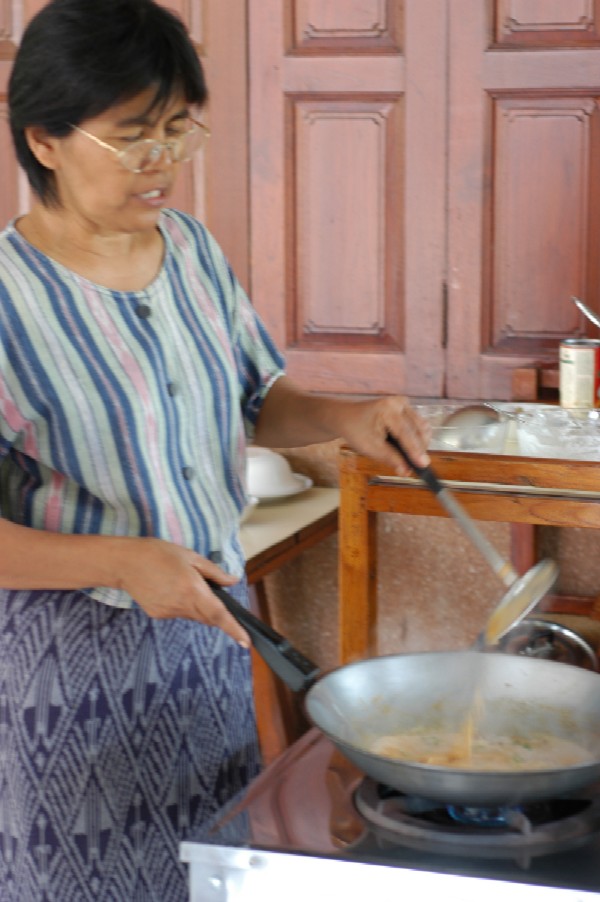 fresh lime juice, the spice from ground chili, and the salty flavor was imparted by fish sauce. Pip described each and every one of the ingredients that would go into our recipes and demonstrated how we should prepare them. We practiced cutting and preparing the various ingredients ourselves; lemongrass, cilantro, galangal (the spicy cousin of ginger and turmeric), tiny bird's eye chilis, kaffir lime leaves, basil leaves, leeks, onions, straw mushrooms, and more. Cutting ingredients seems like a straightforward task until you understand how the different methods affect the flavor and presentation of the food. Our teacher also threw in tidbits about other uses for the ingredients. Kaffir limes aren't good to eat but can be used to wash your hands or to nourish hair. Turmeric is good for acne. Leek leaves are good for the heart. As we worked with the various ingredients, the distinct aromas and textures of the foods came to life. fresh lime juice, the spice from ground chili, and the salty flavor was imparted by fish sauce. Pip described each and every one of the ingredients that would go into our recipes and demonstrated how we should prepare them. We practiced cutting and preparing the various ingredients ourselves; lemongrass, cilantro, galangal (the spicy cousin of ginger and turmeric), tiny bird's eye chilis, kaffir lime leaves, basil leaves, leeks, onions, straw mushrooms, and more. Cutting ingredients seems like a straightforward task until you understand how the different methods affect the flavor and presentation of the food. Our teacher also threw in tidbits about other uses for the ingredients. Kaffir limes aren't good to eat but can be used to wash your hands or to nourish hair. Turmeric is good for acne. Leek leaves are good for the heart. As we worked with the various ingredients, the distinct aromas and textures of the foods came to life.
After all of the cutting and preparing was complete Pip showed us how to make curry paste, the principal ingredient for Thailand's yellow, green and red curries. Unlike their Indian counterpart which are mostly flavored with a mixture of dried spices, Thai curries are created with more fresh ingredients, like the spicy galangal and fresh lemongrass. The yellow curry, however, gets its vibrant color from the addition of dried curry powder, which includes turmeric. Making the curry paste was definitely the most labor intensive part of the class. Pip used a large pestle and mortar to grind a mixture of star anis, cumin, coriander seed, and pepper corn into a powder. Then she added, in order, kaffir lime skin, galangal, dry red chili, lemongrass, salt, shallots and garlic, and shrimp paste. Initially it just made a fibrous mush but she kept pounding away, giving each of us a turn at converting the mush to paste. We didn't make it all of the way to a finished product but she told us it should be a smooth paste when done. When she was a little girl she would yell to her mother and ask if the paste was done yet, being tired of pounding the pestle and mortar. He mother would ask if it still looked like elephant poop. If is still looked like elephant poop then it wasn't done! Pip let out a laugh as she told the story. It was a rather unsavory analogy but having seen a bit of elephant poop myself it was adequately illustrative. It would certainly take time to turn that fibrous lump of ingredients into an evenly mixed paste. It is a good thing that ready made paste is available! and garlic, and shrimp paste. Initially it just made a fibrous mush but she kept pounding away, giving each of us a turn at converting the mush to paste. We didn't make it all of the way to a finished product but she told us it should be a smooth paste when done. When she was a little girl she would yell to her mother and ask if the paste was done yet, being tired of pounding the pestle and mortar. He mother would ask if it still looked like elephant poop. If is still looked like elephant poop then it wasn't done! Pip let out a laugh as she told the story. It was a rather unsavory analogy but having seen a bit of elephant poop myself it was adequately illustrative. It would certainly take time to turn that fibrous lump of ingredients into an evenly mixed paste. It is a good thing that ready made paste is available!
Once all of the hard work was done the final assembling of the dishes seemed to go like a flash. Using not much more than a single wok set on medium heat, Pip turned out one dish after another. Wok cooking is a quick process but there is definitely skill involved. We had to watch closely to see what she was doing. Mixing the curry paste into th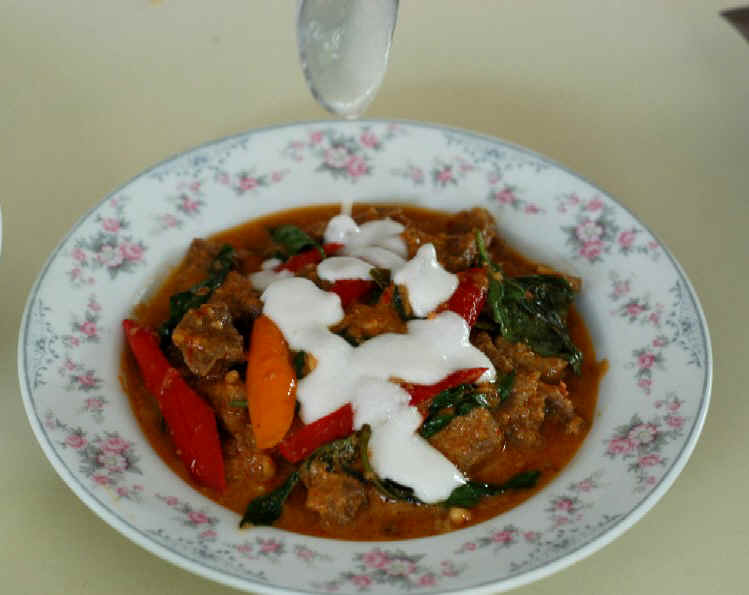 e coconut milk was a gradual process of thoroughly incorporating the paste and letting the milk cook down until it became thick, then adding more milk and more paste. But it was the only thing that took any time at all. She gave each of us a turn. Frying the egg for the phat thai looked deceptively easy but if not done right would result in scrambled eggs. She coated the wok with the whites and then broke the yolks and swirled them on top. The result was a thin egg crepe that broke into fine strips. Before we knew it there were five colorful dishes laid out on the table and they were all delicious. It was as new standard for Thai food. The sour and spicy soup wasn't an extremely firey version but had some kick and plenty of flavor. The savory pork salad had the added texture of roasted rice and was garnished with fresh mint leaves and served with an assortment of fresh yard-long beans, cabbage, shallots, and spring onions. The chicken curry was a vibrant yellow from the dried curry ingredients and the red beef curry was garnished with stripes of thickened coconut cream. And, the phat thai was an explosion of colors with fresh cilantro, crunchy bean sprouts, yellow egg strips, and rosy shrimp. It was a feast for the eyes as well as the stomach. My favorite was the b e coconut milk was a gradual process of thoroughly incorporating the paste and letting the milk cook down until it became thick, then adding more milk and more paste. But it was the only thing that took any time at all. She gave each of us a turn. Frying the egg for the phat thai looked deceptively easy but if not done right would result in scrambled eggs. She coated the wok with the whites and then broke the yolks and swirled them on top. The result was a thin egg crepe that broke into fine strips. Before we knew it there were five colorful dishes laid out on the table and they were all delicious. It was as new standard for Thai food. The sour and spicy soup wasn't an extremely firey version but had some kick and plenty of flavor. The savory pork salad had the added texture of roasted rice and was garnished with fresh mint leaves and served with an assortment of fresh yard-long beans, cabbage, shallots, and spring onions. The chicken curry was a vibrant yellow from the dried curry ingredients and the red beef curry was garnished with stripes of thickened coconut cream. And, the phat thai was an explosion of colors with fresh cilantro, crunchy bean sprouts, yellow egg strips, and rosy shrimp. It was a feast for the eyes as well as the stomach. My favorite was the b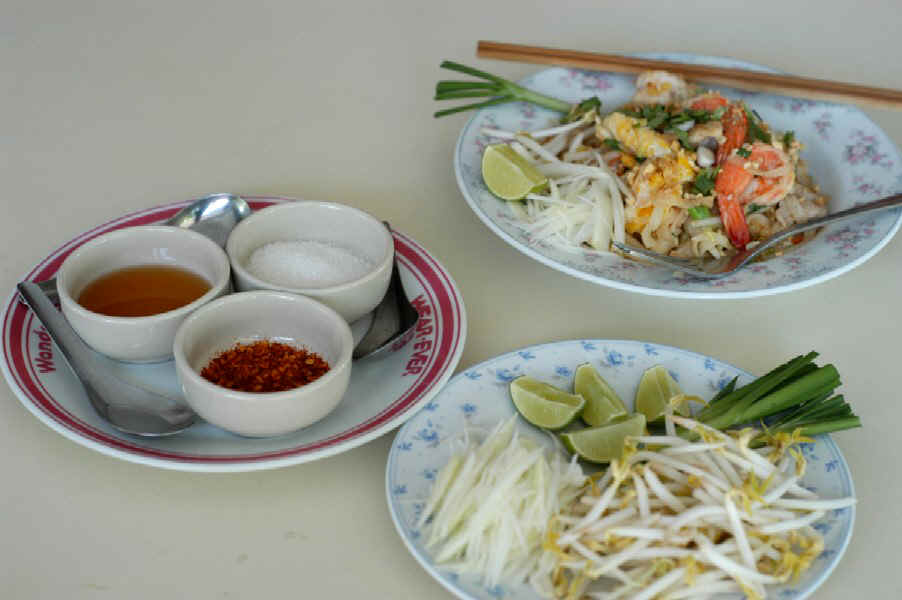 eef curried in sweet peanut sauce -- rich and savory, with a touch of sweetness! eef curried in sweet peanut sauce -- rich and savory, with a touch of sweetness!
Returning to the hotel wasn't as thrilling as the ride over, since we rode in the van, but it was more comfortable on a full stomach. We had a taste of afternoon traffic but was I happily back at the hotel in no time at all. |
SRI LANKA
Colombo
Oct 25
Oct 26
Oct 27-29
Nuwara Eliya
Oct 30
Oct 31
Kandy
Nov 1-5 (1)
Nov 1-5 (II)
Polonnaruwa
Nov 6
Sigiriya & Dambulla
Nov 7
Colombo
Nov 8
INDIA
Ft.Cochin
Nov 9-15 (I)
Nov 9-15 (II)
Nov 16
Nov 17-18
Madurai
Nov 19
Nov 20
Tiruchirapalli
Nov 21
Nov 22
Nov 23
Chennai
Nov 24
Nov 25-26
Nov 27-28
Ft.Cochin
Nov 29
Lakshadweep
Nov 30-Dec 4 (I)
Nov 30-Dec 4 (II)
Trans-India Train
Dec 5-7 (I)
Dec 5-7 (II)
Siliguri
Dec 8
Darjeeling
Dec 9
Dec 10-13
Dec 14
Sikkim
Dec 15
Dec 16-20
Dec 21-23
Dec 24
Dec 25
Darjeeling
Dec 26
Dec 27-Jan 2
Siliguri
Jan 3
Jaigon
(Bhutan)
Jan 4
Kolkata
Jan 5-6
THAILAND
Bangkok
Jan 6-13 (I)
Jan 6-13 (II)
Jan 6-13 (III)
|

